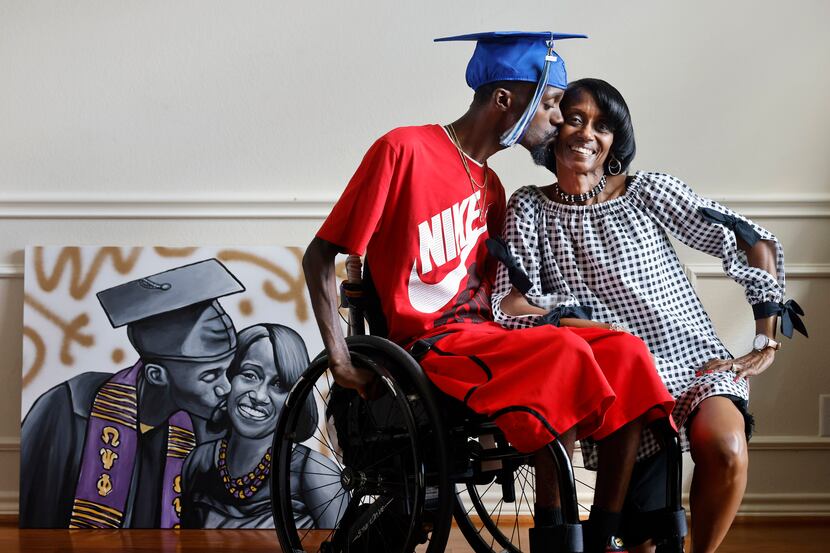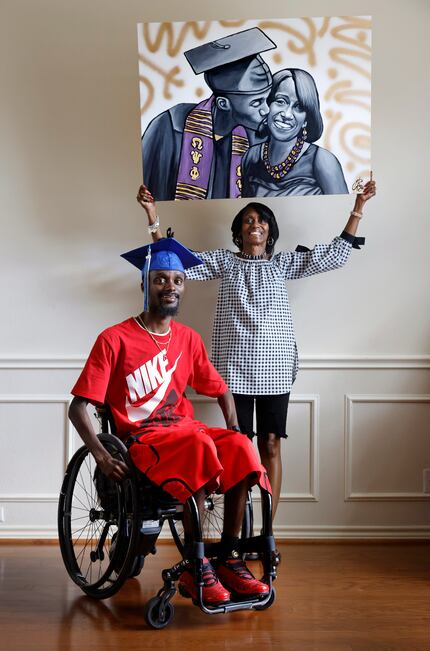A promise kept: How Corey Borner, left paralyzed by a football injury at DeSoto, walked again
Borner became paralyzed after attempting a tackle at a football practice 12 years ago. He promised he would one day get up.

11:25 AM on Sep 22, 2021 CDT — Updated at 2:25 PM on Dec 31, 2021 CST
DeSOTO — For most of the last 12 years, since the spring day he went in with his head a little too low to make a tackle at a DeSoto practice and didn’t get up, Corey Borner didn’t just dream of walking again. He promised he would. He seemed so confident, so sure, his friends wanted to know when.
“It’s all in God’s hands,” he’d tell them.
But as the years passed and Corey didn’t get up from his chair, his vow became a hard sell. Statistics suggest the longer that victims of a spinal cord injury go without walking, the greater the odds they never will. The best chance of recovery is in the first six months.
Not after 12 years.
The latest news, analysis, predictions and more for each season.
While Corey waited on God, he got on with his life. Graduated from high school. Became a motivational speaker. Even earned a degree.
Before graduating last month from UNT-Dallas, he told friends a “special person” would be coming to the ceremonies. Someone special was always coming to see Corey. Deion Sanders. Terrell Owens. DeSoto guys, too. Ellis Hobbs, who played for the Eagles, and Tim Brown, the Heisman winner from Woodrow Wilson. Greg Abbott, then Texas’ attorney general, came in his wheelchair. Mack Brown came with two Texas watches and a Big 12 championship ring with Corey’s name on it. Friends couldn’t get over the celebrities lining up. Who’s it going to be this time, Corey?
Who’s next?
Turns out it wasn’t a “who.”
It was a promise made good.
That’s my ‘me time’
Considering his C5 and C6 vertebrae were fused in a nine-hour operation in 2009 and Corey still has no real feeling below his chest, it can be a little disconcerting to watch him talk. He never stops moving. His head jabs, his arms circle, his lean torso twists rhythmically from side to side. Part of the reason for the repetitive movement is his nonstop therapy to ward off pressure sores and stimulate his central nervous system. Part of it is that he’s not much good at holding his emotions in check.
Tim Brown remembers what it was like when they met.
“When this thing happened with Corey,” he said, “I was waiting to hear from the Hall of Fame and was pretty salty that I didn’t get in on the first or second ballot. Being that I was living in DeSoto and he was playing for DeSoto, this story was everywhere. I sorta got one of these epiphanies. You’re bellyaching about being in the Hall of Fame, and this kid may never walk again. I just felt the need to reach out and encourage him.
“Once I spoke with him and saw his resolve, I felt inspired to let him know that things happen in our lives for a reason. If you’re still here, you need to go tell somebody what you went through. He’s such an inspiration to be around.
“I should be sitting in front of him once a week.”
Corey took Brown’s advice to heart. Even got a publicist. He’s spoken to football teams and schools and churches.
Every time he talks, the subject gets easier.
“It’s what you live,” he said. “It’s how you live. To get up there, it’s like therapy for me. I don’t see the crowd, I don’t see the cameras. It’s like getting ready for a football game.
“You’re locked in.”
He’s got a story to tell, all right. Before his life changed forever at 16, he was just a bubbly, energetic kid with a wide array of interests. Lil’ Corey, rapper and dancer. Football player, too. He wanted a lot out of life, and it seemed impossible to deny him anything. Even his injury came after he asked his coaches for one more play.
The first year was the hardest for everyone in the Borner family. Had the DeSoto school district not hired a nurse specifically to attend to Corey, Charlotte Borner isn’t sure they would have made it. Corey requires help pretty much 24 hours a day. The first five years, they went through five caregivers.
Finally, in 2014, Charlotte quit her job and her husband, Michael, took a second job so she could care for their son.

Does it seem like 12 years?
“To me,” she said, “it seems like yesterday. Not a day goes by I don’t think about something from before. I can look at pictures of him standing or playing with his brothers or riding his bike, and it still seems like yesterday.”
The Borners are a close, God-centered family. Brandon, the oldest of their three sons, lives in Dallas. Daunte and his daughter live with his parents and he helps with Corey.
Depending on someone else for everything is the most difficult aspect of his life at 28, Corey said. He’d like to do something so simple as to get in a car and drive somewhere without asking. He knows someone will take him. He knows they’re glad to. But it’s on their time, not his.
Which is why he wheels himself out the front door of their comfortable home, down a metal ramp and to the dwindling shade of a time-ravaged tree.
“That’s my ‘me time,’” he said. “I spend a lot of time under my tree out here. Me and God. I love being outside. Enjoy the weather. Just me. Reminisce on things I used to do walking. On football.
“A lot of different stuff.”
The second week of June, sitting under his tree, he thought of his rehab a couple days earlier at Baylor Scott & White. He’d been fitted with something called an exoskeleton suit, a contraption straight out of a “Terminator” movie. Harnesses and hinges from head to toe. The technology got its start in the ‘60s for military usage, but it’s since been repurposed to use in rehabilitation and commercially to reduce injury rates as well as liability costs. “Passive” exosuits, for industrial use, are relatively inexpensive. “Powered” versions help people walk, even run, and cost tens of thousands of dollars. Only 6,000 were in use in 2019, with most designated for rehabilitation. Industry research projects 2.6 million by 2025.
Corey’s physical therapists asked him in June if he wanted to try out an exosuit made by Ekso Bionics, which was like asking a man dying of thirst if he’d like a drink.
The first time Corey tried on the exosuit, he stood up and looked down at his feet. Told his therapists to give him a minute. Been a long time since he’d enjoyed the perspective.
Finally, a walker out front, a therapist to the rear and the exosuit enveloping him, he led with his right foot.
Once assured he wouldn’t fall, he followed the lead of the exosuit as it counted his steps.
His first day total: 526.
How did it make you feel?
“Nervous happy,” he said last week. “I’m nervous because I haven’t walked in 12 years. Happy because I’m finally gonna take some steps. Happy to see my mom smile.
“She didn’t cry or nothin’.”
Not because she didn’t feel like it.
“Well, I was overwhelmed, really,” she said. “Happy and excited. He’s always said he was gonna walk again, and with his faith and determination, he did it.”
Corey didn’t cry, either. Not at rehab, anyway. It didn’t hit him until two days later at home, sitting out under his tree.
And then he asked God a question.
“How many steps can I do next?”
An inspiration
Five North Texas high school football players suffered spinal cord injuries that left them unable to walk in the first decade of this century. First Everman’s Corey Fulbright, in the 2002 Class 3A state title game; then Carrollton Turner’s Nat Little in 2004; Borner and Pinkston’s Jared Williams in 2009; and Molina’s Diondre Preston in 2010. They became a fraternity of sorts. A San Antonio man, Eddie Canales, whose own son was paralyzed playing football, created the Gridiron Heroes Spinal Cord Injury Foundation to defray some of their expenses and offer a like-minded support group.
Corey Borner calls Fulbright “legend” because of his status in the group. Fulbright was only five months removed from the accident when I wrote about his high school graduation in 2003. He’d vowed that he would walk at his ceremonies. Watching him wheel across the stage, I’d hoped the ovation drowning out his introduction had at least lifted his spirits.
Science has come a long way in the two decades since. Corey Borner hadn’t really counted on it even as he made a guarantee of his own. He figured it was a matter between him and God. He wanted to be an inspiration. He wanted to give the 7-year-old girl in a wheelchair who asked if people laughed at him, too, someone she could look up to. He wanted to prove the inevitable doubters wrong.
Of all things, he wanted to surprise the people who believed in him. What made him happiest at graduation, he said, was seeing the reaction of his old football coach, his grandfather, his father, friends and mentors.
“Almost had me in tears,” Brown said.
RETWEET THIS FOREVER! SO I SHOCKED THE WHOLE WORLD! WHEN YOU SURPRISE THE WORLD WALKING ACROSS TO RECEIVE YOUR COMMUNICATION DEGREE! THIS IS THE BIGGEST MOMENT IN MY LIFE!!!! ! I WILL CONTINUE TO NEVER GIVE UP & INSPIRE THE WORLD WITH MY TESTIMONY. I WALKED AGAIN! #FINDAWAY ! pic.twitter.com/Puw9B09xcL
— COREY BORNER (@LILCOREY_TRILL) August 15, 2021
No, Corey didn’t cry at graduation, either. You can’t afford to be too sentimental if you’re living his story, which last month made two network television news shows and the Washington Post. City of DeSoto officials even proclaimed Sept. 7 “Corey Borner Day.”
His story is far from finished. He wants to get in the exosuit more often. He’d like one of his own. He figures the more he rehabs in it, “the more my legs will come back. I believe that.”
Whether there’s any science behind that belief is a question for someone else to ask. No more proof required here. Corey Borner walked again. He was as good as his word.
Find more Sports coverage from The Dallas Morning News here.